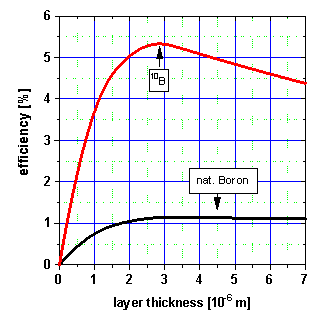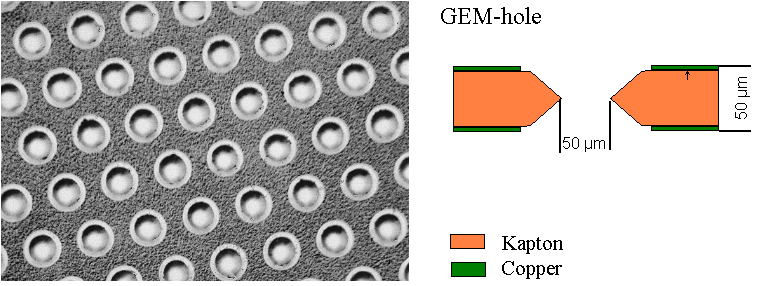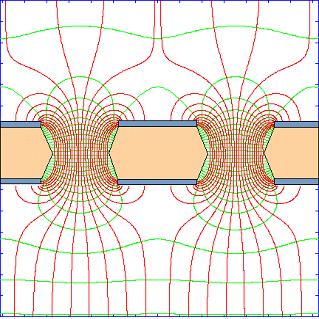The new Detector Concept
Properties of Solid Neutron Converters
The Challenge with Insufficient Detection Efficiency
The GEM, a Substrate Transparent to Charges
CASCADE: The Efficient High-Rates Area-Detector for Neutrons
Properties of Solid Neutron Converters
Use of a solid neutron converter allows to employ any cheap counting gas in flow-through modus. Cleaning by constant throughput of fresh counting gas avoids ageing effects within the detector. In order to maintain the negligibly low gamma sensitivity of gas detectors, their enormous advantage over other detector concepts, a solid converter of 6Li or, alternatively 10B is used. Both, for their low Z, produce hardly any photo electrons on gamma impact. 10B has, as opposed to 6Li, a much higher cross-section of absorption for thermal neutrons. The primer advantage of B, however, is its chemical inertness, so that the material can be exposed to roughly any harsh environment.
The charged conversion products (a-particle and 7Li-nuclei) of the neutron capture reaction in 10B produce very high ionization densities in adequate counting gases even at atmospheric pressure. The center of gravity of the charges produced is limited to a range of 1-3 mm around the point of conversion. This results in a spatial resolution of 2-6 mm, by far sufficient for many applications. With an operative pressure equal to the environmental pressure, lightweight, easy to handle and in particular large area detectors can be constructed. They can even be arranged in an array configuration with very limited loss to blind areas. Further, semi-spheric constructions, ideally suited for scattering applications are now easily feasible.
The Challenge with Insufficient Detection Efficiency

Detection efficiency of one single solid Boron layer calculated for thermal neutrons in dependency of the layer thickness.
The principle challenge
when using solid converters is the detection of the charged particles emerging
from the conversion process. Most of these charged products are absorbed within
the solid converter itself so that they cannot deposit their energy in the detection
medium, e.g. a surrounding counting gas. Only if the conversion products manage
to leave the bulk of the converter they can be detected. So apart from neutron
capture cross section the ratio of surface to volume of the solid converter
determines the overall detection efficiency for neutrons. The advantage of high
density of nuclei in a solid converter is jeopardized by the insufficient escape
probability of the charged fragments from the bulk solid converter.
Up until now it was impossible to use several thin layers solid converter material
in a cascade in order to enhance detection efficiency, as the subsequent layer
was impenetrable for the ionization signal, a cloud of electrons and ions. Extraction
in other directions inevitably spoils the information on position. An ideal
carrier substrate for the converter material would have to be completely transparent
for the charges produced.
The GEM, a Substrate Transparent to Charges
Since 1997 a substrate is available that has this property of charge transparency, the GEM. The GEM (= Gas Electron Multiplier) was developed by F. Sauli at CERN in 1997.
Any use of GEM foils in detectors is protected by patents owned by CERN and requires a written license from CERN. Such a licence is free of charge for R&D purposes. Commercial licenses can be granted on conditions to be agreed with CERN. More information about GEM licencing can be found at http://cern.ch/gem.

GEM from above (left) and GEM-hole cross-sectional view (right)
GEMs are Kapton foils (50-100 mm thick), that are coated on both sides by a thin layer of copper (5-15 mm thick). Most importantly, these foils are covered with a regular pattern of through going holes, 50 mm in diameter and at a lattice spacing of about 150 mm.

Sketch of the electric fieldlines in a GEM (picture by Sauli, CERN)
Both
layers can be individually contacted electrically. If the potentials on these
electrodes are chosen adequately, homogeneous field lines far above the hole
structure will be channeled right through these holes and the GEM. The fields
are formed in such a way, that charges from above the GEM will be channeled
and imaged undistorted to below the GEM. In an intuitive manner, these GEMs
can thus be cascaded one behind the other. Application of a thin coat of a solid
neutron converter material onto such a GEM provides the charge-transparent,
solid neutron converter layer.
With charge transparent layers of a solid neutron converter available, the complete
technology of standard gas detectors can readily be employed towards the construction
of a neutron detector. The transparency for charges allows to cascade several
such layers one behind the other collecting single layer detection efficiencies.
In such a cascade, an overall detection efficiency for an impinging neutron
can be obtained that challenges the standard single channel 3He-Neutron
counter tube. Depending upon the conversion material, detection efficiencies
of up to 80% are feasible. The Volume between successive layers is filled with
an ordinary counting gas employed in genuine gas detectors.
CASCADE: The Efficient High-Rates Area-Detector for Neutrons
The CASCADE Neutron Detector is a detector constructed from a cascade of several GEM-foils which are coated with a 1-3 mm thick layer of neutron converter material such as 10B. This detector is operated at ambient pressure. The robust detector can easily be built to cover large areas with a lightweight housing (1-2 kg for an active area of 30 x 30 cm2). The planar stack of the converter foils can be read out by means of a simple readout structure. This structure can be adapted to meet specific needs such as e.g. pure azimuthal resolution and integration over j or simply 2D resolution (3 x 3 mm2). With a stack of several (~10) converter sheets, detection efficiencies of about 50% for incoming thermal neutrons (1.8 Angström) can be achieved. With a drawback in spatial resolution, even 80% detection efficiency is feasible. For typically employed neutron wavelengths of 3.5 Angström, only half the number of converter sheets is needed, that is six singly or three doubly coated GEM foils! Furthermore, the detector provides sub microsecond absolute time resolution, opening the door towards new TOF applications.

Sketch of the detector: a cascade of
GEM-foils coated on both sides with Boron and Boron-coated driftelectrodes. Primary electrons,
produced by the escaping a-particle of the neutron conversion,
are guided undistorted through all of the GEMs onto an arbitrary readout-structure.
The features of this new position sensitive gas detector for thermal neutrons are:
- The operation under normal pressure allows to construct cheap and lightweight detectors, which are easy to handle and can cover large areas.
- The cascade of Boron coated GEM-foils allows detection efficiencies of about 40-50% for thermal neutrons (1.8 Angström).
- The use of GEM-foils allows high count rates up to 107 n/cm2s [Bre99] .
- The spatial resolution is at the moment about 2.5 mm.
- Flowing cheap counting gases through the detector avoids ageing effects.
- Because of the low-Z of 10B, because of the high energy of the charged conversion products and in his capacity as a gas detector the detector is free of Gamma-underground.
- The detector provides sub microsecond absolute time resolution, opening the door towards new TOF applications.

